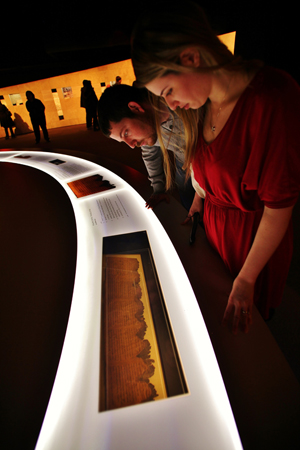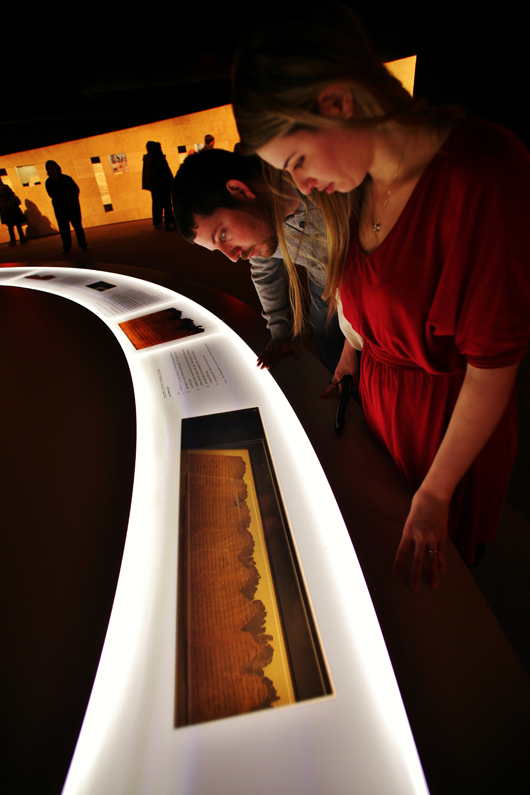
PHILADELPHIA (AP) – Inside a climate-controlled storage room with a guard posted at the door, Tania Treiger unzips a purposely nondescript case and lifts out one of the world’s oldest and most significant archaeological artifacts.
The Israel Antiquities Authority conservator is one of only four people in the world allowed to handle the Dead Sea Scrolls, the centerpiece of a new exhibition at The Franklin Institute, where a painstaking examination of the ancient treasures was conducted before they are placed on public view.
“Dead Sea Scrolls: Life and Faith in Ancient Times” opened Saturday and runs through Oct. 14. The 20 scrolls chosen for The Franklin Institute—the first set of 10 will be switched with 10 others halfway through the five-month exhibit—contain handwritten texts from several books of the Old Testament including the opening passage from Genesis, “In the beginning, God created the heaven and the earth.”
Several days before the show’s opening, Treiger and Pnina Shor, curator and head of the Dead Sea Scrolls Project, who is also based at the independent governmental organization in Jerusalem, provided a rare behind-the-scenes look at the “condition reporting” that happens every time the fragile 2,000-year-old scrolls travel.
“The condition report means we are documenting the state of the scroll when it leaves our premises and when it reaches the venue,” Shor said. “Both sides want to make sure we are receiving it in the same condition.”
Treiger placed a climate-controlled sealed frame containing a remarkably intact leather parchment known as the Psalms Scroll on a long table and, joined by Franklin Institute curator Cheryl Desmond, compared it to a same-size photograph with penciled notations of the tiniest ding, scrape and pit on the 3-foot-long parchment. Under bright magnifying lamps, the pair exhaustively examines the scroll for any changes that may have occurred in transit.
After more than an hourlong inspection, everything looks fine. No changes have so far been noted in any scrolls during these examinations, Shor said with a sigh of relief.
“This scroll arrived yesterday, then it needs 24 hours of acclimatization: It comes in, it relaxes for 24 hours and only now do we open (the case),” Shor said. “Once everyone is satisfied that there is no change, then it is brought down to the exhibition hall and placed in the climate-controlled case that was created especially for it.”
Temperature, humidity and light will be carefully and constantly monitored throughout the exhibition; light levels are calibrated based on how many hours the hosting museum is open each day. The scrolls are displayed for no more than 90 days a year, after which they are put away to “rest” in storage for at least a year.
“The scrolls are made of parchment or papyrus, both are organic materials,” Shor said. “It’s like your skin—you have to nourish them, you have to take care of them. We talk of them as though they are alive.”
What a difference from the years immediately after the scrolls’ discovery.
A video in the exhibit shows scholars working in bright sunlight with cigarettes smoldering between their lips and joining scrolls with adhesive tape—a nifty innovation in the 1950s that caused unforeseen irreversible darkening and staining. Now, Treiger and three colleagues in Jerusalem are gingerly working to undo or stabilize the damage.
Two decades ago, experts in Israel and from the Library of Congress in Washington developed a new technique to house delicate relics. The scrolls are first sewn between two layers of polyester netting stretched in acid-free mounts, then encapsulated in a climate-controlled frame made of polycarbonate plates.
Because conservation science is new and evolving, experts from the U.S. and around the world are now re-examining the method to ensure it is keeping the scrolls stable and undamaged and considering additional refinements to the process, Shor said.
“The idea of this all is to preserve them as long as possible,” Shor said. “They were preserved in the caves in the Judean Desert for 2,000 years and our duty is to preserve them at least 2,000 years more, so every precaution is made to do that while sharing this heritage with the public.”
Though the scrolls are the centerpiece of the show, there are 600 more items on display, including pottery, glass, coins, architectural elements and a three-ton stone from Jerusalem’s Western Wall. Prayer notes left by exhibition visitors will be brought to the Western Wall and placed in its crevices, a ritual performed by pilgrims to the holy site for hundreds of years.
The scrolls, considered by many to be the most significant archaeological find of the 20th century, are thought to have been written or collected by an ascetic Jewish sect that fled Jerusalem and settled at Qumran, in the Judean Desert on the banks of the Dead Sea.
The ancient holy books and apocalyptic texts were found between 1947 and 1956 in 11 caves where they had been preserved by the arid climate inside large clay jars for two millennia.
Portions of the roughly 900 manuscripts that were eventually discovered, some fragmentary and others intact, contain the earliest known versions of portions of the Hebrew Bible and have shed light on the development of Judaism and the beginning of Christianity.
The exhibit, previously on view with a different set of scrolls at Discovery Times Square in New York City, was created by the Israel Antiquities Authority from the collections of the Israel National Treasures. It likely will travel to other U.S. cities after the Philadelphia run, but the process of evaluating potential facilities is still under way.
___
Online:
Exhibit: http://www.fi.edu/scrolls
Copyright 2012 Associated Press. All rights reserved. This material may not be published, broadcast, rewritten, or redistributed.
AP-WF-05-11-12 1944GMT
ADDITIONAL IMAGE OF NOTE


